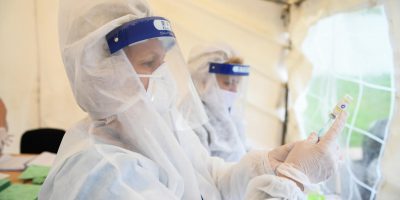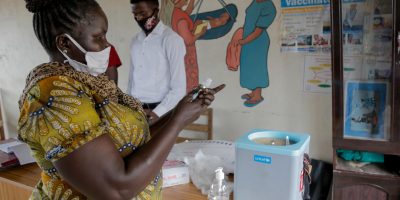Is the global pandemic the moment to reimagine health systems? SSHAP asked Simone Carter, champion of operational research to influence outbreak response, manager of the Social Science Analytics Cell (CASS) in the DRC and lead for Integrated Multidisciplinary Outbreak Analytics (IMOA) for UNICEF’s Public Health Emergencies team what she thinks.
The Sixth Global Symposium for Health Systems Research is calling for the global community to ‘reimagine health systems’ for better health and social justice – what does this look like to you?
That it is imagined by women and adolescents, by those who have the most difficulty accessing services (be it for security, stigma, socioeconomic circumstance or structural barriers). That it is imagined with an equity approach and by the users rather than suppliers. That it is not another product of patriarchy or colonialism. That it reflects and delivers a holistic model of health rather than a narrow bio-medical focus. That we redefine accessibility; mapping and placing health systems based on new analyses which consider gender and access among many sources of data which should influence location and service.
Many have said that COVID-19 revealed cracks and fissures in health systems across the world. How should this figure into our ‘reimagining’?
I am not sure “it revealed” them. The “cracks” people speak of are actually canyons in healthcare systems and services provision – they have long been there, and we knew this. Choosing not to look at or address them is not the same thing. In a recent SSHAP publication, we highlighted the broader health impacts of vertical COVID-19 response measures. It illustrates how the chasms in health systems have now grown wider with a narrow focus on COVID-19. These impacts are most severely felt by women, gender non-binary, youth, impoverished families and communities, unofficial, undocumented and migrant workers… all those outside of the norm constructed by a primarily patriarchal leadership paradigm.
“Reimagining health systems” must reconsider the data we use to make health decisions (outbreak response, service provision, rehabilitation and systems development). I’ve been listening to Caroline Criado Perez’s recently published book “Invisible Women: Data Bias in a World Designed for Men” which illustrates (as does the SSHAP publication) how critically important it is that any reimagining must start with better data. The data used to develop health strategies (among so many other decisions, plans, structures and systems) must centre on women and youth, and not treat them only as an afterthought. To reimagine health systems, data itself must be reimagined; we need to ask questions which matter to women, adolescents, gender-nonbinary people as well as diverse ethnic and cultural groups.
Reimagining health systems also needs to be done locally, with bottom-up methodologies and data which is representative of those who are most likely to need, but least likely to access care. This requires re-prioritisation and reorientation to local communities;-imagining cannot be one-size-fits-all; it must be imagined locally.
What is the role that social science can play in this reimagining?
To date, the COVID-19 Public Health and Social Measures (PHSM) guidelines for COVID-19 do not consider the 80% increase in domestic violence, nor the 73% of countries who reported malaria service disruption as data which should be included into models for decision-making to inform public health and social measure guidance.
The data exists, so why isn’t it being used? Why is it not considered equally important as the health impacts of COVID-19 itself? Why do the PHSM come first, and dealing with their collateral effects – which impact the most vulnerable most severely – comes second? Why not include them in the same models? Global guidance continues to prioritise one disease, weighing in “secondary” impacts as, exactly that, secondary.
Social science research should be used to engage and facilitate space for programmes like Integrated, Multidisciplinary Outbreak Analytics (IMOA) which brings together outbreak analytics, analysis of health services (DHIS2 or other) data, with social and behavioural analysis of households and healthcare workers in order to understand the differential dynamics and impacts of a disease outbreak and its response measures. But even platforms like this aren’t enough.
Social science evidence can also uncover the causes of decreased use in services (which might be due to- socioeconomic barriers, stigma, PHSM, fear of infection etc – as well as explain spikes in disease elsewhere (which might be due to reduced availability of services, increased cost, lack of transport). However, social science cannot influence action unless it has a seat at the table and be regarded as important as traditional disease transmission and case fatality data when informing health response.
Social sciences should be THE driving force to identify where and how health services and systems can be reimagined, both in the context of health emergencies like epidemics, as well as in non-epidemic times. It is central to placing the experiences, views and needs of people (and getting beyond the currently primarily male-oriented data paradigm) at the forefront.
How can we ensure that any reimagining is tailored to local realities?
Data and money? Although the approach needs to be local, support also needs to come “from above” as much as from community actors. How do we make this happen? I am still not sure. It will certainly take more time and money and requires some to let go of control. This is not easy.
We can also start by putting the evidence that demonstrates the detrimental impacts of not having locally adapted health services and systems on the health agenda. It must be regarded as equally important as treating disease itself. That has yet to happen.
What should key priorities be for health systems researchers and practitioners going forward?
Integrated, Multidisciplinary Outbreak Analytics: over the past two years in the DRC, we have brought together social sciences, epidemiological, DHIS2 among other data to understand health dynamics in an outbreak. Using different data sources to understand cause and effect and health outcomes is critical. We must critically ensure that all data are collected, in all forms, by sex and age at minimum. This is still not happening. How does access vary? What changes are implemented and what impact does this have? We must focus on influencing with evidence and documenting the community health outcomes based on the use of evidence.
Using evidence to validate and promote locally adapted and appropriate solutions to healthcare systems should be reinforced; to replicate and improve accountability.
Any final thoughts to leave our audience with?
Yes actually. I think it’s really important to remember that we don’t always need evidence. We don’t need evidence or research to know that women are critical contributors to health services dynamics. We don’t need evidence to know that women are more likely to suffer exploitation and abuse in emergencies; including disease outbreaks.
Change is not going to come because of evidence of discrimination, change is going to come when you shift the power dynamics in decision-making for health.





